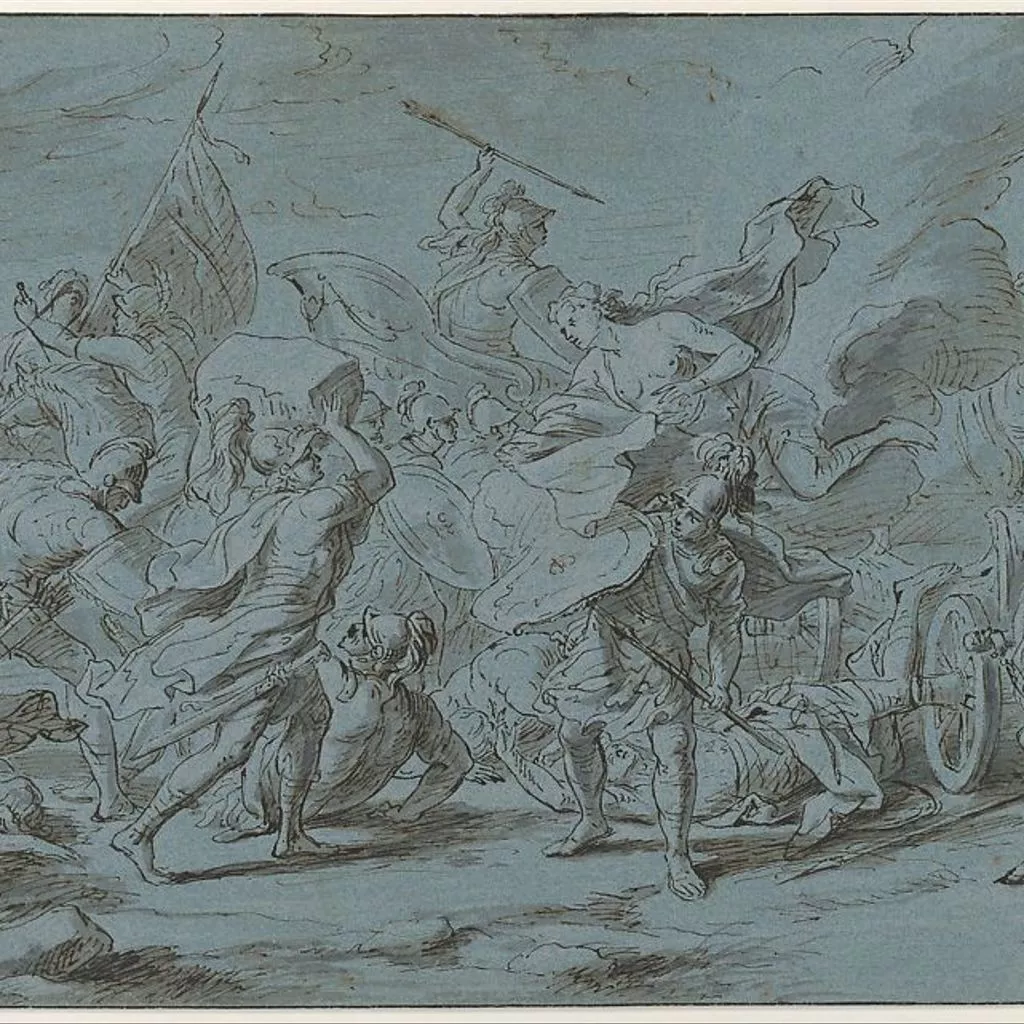Description
Jan van Orley, a distant descendent of the sixteenth-century painter and tapestry designer Bernard van Orley, produced this drawing as a design for a tapestry cycle that was woven in the Van der Borcht manufactory in Brussels in the first half of the eighteenth century.[1] The ten-part program depicts episodes from the life of the Greek hero Achilles, as related in the Homeric epic the Iliad and in other ancient texts. This highly developed preparatory drawing, which came to light in 2012, corresponds to the seventh weaving in the cycle and represents the confrontation, described in the fifth book of the Iliad, between Achilles’s compatriot Diomedes and the Trojan warrior Aeneas (better known as the hero of Virgil’s Aeneid).[2] The two appear at center: Diomedes, with the superhuman strength granted by Pallas Athena, hurls an enormous stone at Aeneas, who has descended from his chariot in order to retrieve the body of his compatriot Pandarus, slain moments earlier by Diomedes. The goddess Aphrodite, Aeneas’s mother, hovers above, veiling her son with her gown in order to protect him from further injury and, ultimately, to transport him away from the battlefield. Various other figures duel on foot and horseback amidst swirling clouds and drapery. Van Orley’s primary model for the series as a whole was the celebrated Life of Achilles tapestry cycle designed by Rubens in the 1630s, known widely through engravings produced in 1679 and 1724. This important precursor does not, however, include the skirmish between Diomedes and Aeneas, a scene that is rarely depicted in the history of art and that is indeed an unusual choice for a program dedicated to Achilles, as it is a battle in which, out of anger, he refuses to take part. His absence highlights, however, not only his temperament but also his exceptional ferocity as a warrior. Shortly after the episode depicted here, the goddess Hera, in order to rouse the Greek troops, remarks that “as long as Achilles was fighting, his spear was so deadly that the Trojans dared not show themselves outside the Dardanian gates, but now they sally far from the city and fight even at your ships” (5.907-8). This may explain Van Orley’s choice to include the episode. For this lively scene, he combined figures derived from prints after ancient statuary and contemporary French paintings.[3] The heroic subject matter, dramatic physical action, and classical types are hallmarks of neo-baroque tapestry design, a style that would give way, beginning about 1725, to the elegant scenes of everyday life that epitomize the goût moderne.[4](JSS, 8/23/2018)[1] Marthe Crick-Kuntziger, “The Tapestries in the Palace of Liège,” Burlington Magazine 50, no. 289 (April 1927), p. 178, first proposed Jan van Orley as the designer of the cycle. Support of this attribution, along with a proposal that Van Orley produced the tapestry cartoons about 1726-30, was offered by Nicole de Reyniès, “Jean van Orley Cartonnier: La Tenture d’Achille au Musée Jacquemart-André,” Gazette des Beaux-Arts 125 (Feb. 1995): pp. 155-76. See the latter as well for a list of the extant weavings, particularly the set of nine in the Musée Jacquemart-Andre, Paris (one of which—the tapestry pertaining to the present drawing—was at some point cut into two pieces). [2] Nicole de Reyniès, “Jean van Orley Cartonnier: La Tenture d’Achille au Musée Jacquemart-André,” Gazette des Beaux-Arts 125 (Feb. 1995): pp. 156, 158-59, brought to light a document from the Van der Borcht manufactory that lists the titles of the ten weavings and, on the basis thereof, identified the subject of the tapestry that corresponds to the present drawing, previously known under incorrect titles including the Battle of Ajax and Hector. [3] See Nicole de Reyniès 1995, pp. 166-67.[4] See Koenraad Brosens in Tapestry in the Baroque: Threads of Splendor, ed. Thomas Campbell (New York: Metropolitan Museum of Art, 2007), p. 452.





